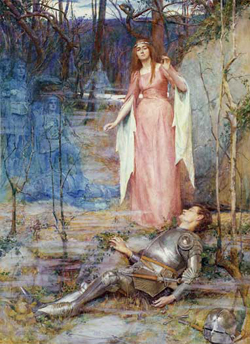 I was very impressed by the quality of the stories to be found in the first Heroines anthology, and (while feeling somewhat daunted) I was determined to try writing something to submit to the second anthology.
I was very impressed by the quality of the stories to be found in the first Heroines anthology, and (while feeling somewhat daunted) I was determined to try writing something to submit to the second anthology.
The focus of the anthologies is on “reclaiming the stories of women in history and reimagining the heroines of legend, fairytale, and mythology”. I’m a fan of John Keats, and I love his ballad “La Belle Dame sans Merci”, so I felt that was a good place to start.
La Belle Dame of the ballad – the beautiful woman without mercy – is only seen from the knight’s point of view. She seduces men away from life and hope, and condemns them to lingering in a shadowy nowhere, caught between life and death.
Many of us will be familiar with the imagery, even if we’ve never read the poem, as the femme fatale trope has long been popular. The Pre-Raphaelite painters in particular were inspired by Keats’ ballad, producing a number of works including the one above, painted by Henry Meynell Rheam in 1901 (source: Wikipedia).
“But what is the woman’s point of view?” I wondered. None (few?) of us see ourselves as the villain of the story. Maybe she is performing a useful service, saving them from the experience of a painful death, gathering more knights for King Arthur in his long slumber, or something along those lines. When I mused about this to my sister and fellow author, Bryn Hammond, she immediately pointed me at the Valkyries, who collected slain heroes from battlefields and took them to their reward of an afterlife in Valhalla.
And so was born Lily, my gentle, English pastoral version of a Valkyrie, who we meet in the no man’s land between the trenches of the Great War…
The story itself is rather short, but it captures what I wanted to say and in its way covers rather a lot of ground. I hope you will be intrigued enough to give it a try! I can guarantee you that Chooser of the Slain is at least in very good company.




 I contributed two stories to A Pride of Poppies, the first being No Man’s Land. The main character in this story is 21-year-old Drew, who was born intersex and raised as a man. We discover during a conversation between Drew and his doctor that perhaps the decision about his initial gender assignment was made for the wrong reasons – his father demanded a son – but Drew is fiercely attached to his identity as a man.
I contributed two stories to A Pride of Poppies, the first being No Man’s Land. The main character in this story is 21-year-old Drew, who was born intersex and raised as a man. We discover during a conversation between Drew and his doctor that perhaps the decision about his initial gender assignment was made for the wrong reasons – his father demanded a son – but Drew is fiercely attached to his identity as a man.